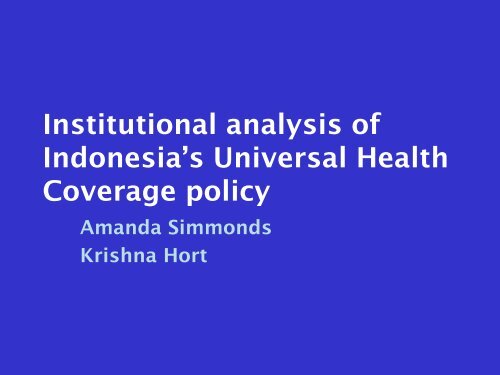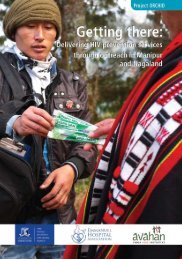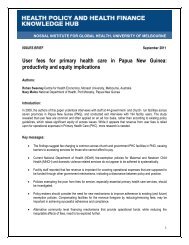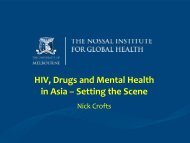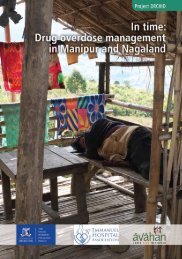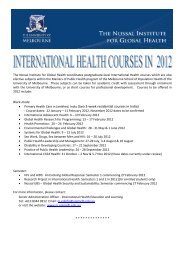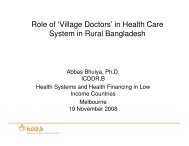You also want an ePaper? Increase the reach of your titles
YUMPU automatically turns print PDFs into web optimized ePapers that Google loves.
Institutional analysis ofIndonesia’s Universal HealthCoverage policy<strong>Amanda</strong> <strong>Simmonds</strong>Krishna Hort
Analysis of Indonesia’s UHC design• Commitment for UHC by 2019• 2012 : Roadmap toward UHC launched• Documentary analysis of Roadmap– health financing functions (eg. Mathauer & Carrin 2010)– social and political aspects (Savedoff et al, 2012)– Laws and Regulations– Recommendations for UHC (eg. WHR 2010)• Identified issues with:– the system design– translating the design into a functioning healthfinancing system– impact of health financing strategy on the rest of thesystem
Table 1: Health Insurance coveragein Indonesia, 2012TYPE OF HEALTH INSURANCEParticipants of Health Insurance for Civil Servants(Askes PNS)TNI/Polri- military and policeJamkesmas Participants* (Ministry of Health)- health insurance for the poorJPK Jamsostek Participants(workforce social security)- Private employees and employersJamkesda/PJKMU Participants- regional health insurance for the poorPERSONS17,274,5202,200,00076,400,0005,600,00031,866,390Corporate Insurance (Self-Insured) 15,351,532Commercial Health Insurance Participants 2,856,539Total 151,548,981* Source: Republic of Indonesia 2012. Roadmap toward National Health Insurance, 2012-2019
Proposed UHC system• National agency by 2014 (BPJS I) to manage theINA-Medicare system1. Integrate existing schemes by 2014– public contributions + government’s contributions for thepoor (Jamkesmas) into a single pooled fund– Regional government schemes (Jamkesda) - to beprogressively integrated– 151.5 million participants2. Expand coverage to uninsured by 2019– projected population 257.5 million
Table 2: Financing Indonesia’s UHCResource collection Pooling Purchasing/ProvisionGovernment budget to publicfacilities (ongoing)Government contribution forpoor and near poor:Rp. 22.000-27.000 per month($2.20-2.70)*Self funded contributionsLaborers – 5-6% of monthlywagesNon-wage laborers/informalsector – 5-6% of monthly wagesOR to be covered bygovernment?*Existing funds to bepooled : BPJS tomanage- Jamkesmas- PT Askes- Jamsostek- Jamkesda (some)2014: 121.6 million2019:Entire population,including remainderof Jamkesda schemesTOTAL: 257.5millionPayments to public andprivate health facilitiesPHC public & privateproviders: capitationHospitals : DRGs (INA-CBG) based payments tobe negotiated and varyaccording to regionBenefit package:- comprehensive- initially third classhospital for govt funded +second class for self funded- second class for all by2019*
Findings : 1. The system design• Costing of the design– Absence of fiscal study– Design recommended Rp. 22.000-27.000 permonth ($2.20-2.70) government contributions forthe poor•↓ to Rp. 15.500 per month ($1.50) as per MOF• Informal sector (~62% of all workers)– Design has government paying contributions, but•defined as contributors in Pres. Reg. on HealthInsurance•collection of contributions unresolved•social protection?
1. The system design(con’t)• Targeting the poor– underutilisation of Jamkesmas benefits, esp.rural and remote– less than 50% Jamkesmas are poor or near poor• existing issues not addressed in design• Ongoing supply-side funding for public healthfacilities– distorts cost of Jamkesmas– limits incentives for service improvement/localgovernment investment in health– compensation for private sector?
2. Translating the design into afunctioning HF system• Collection of contributions– Law 40/2004: contributions to be jointly borneby employers and laborers– changes to existing schemes (eg. Jamsostek)• Integration of regional funds (Jamkesda)– concerns re centralised management– regions to continue providing health insurance• PT Askes’ integration of existing insuranceschemes– need to standardise contribution values,provider payment mechanisms, benefit packages• Inter-institutional arrangements– reaching consensus?
3. Impacts of the HF strategy on the restof the system• Potential for inequities– eg. experience of poor accessing Jamkesmas,limits of benefit package– MOH Action Plan to address health servicesaccess and quality?• Addressing inefficiencies– Not strong focus in Roadmap– Capitation, but may result in user fees– Eg. rise in pharmaceutical spending expected• Private sector participation– Incentive?
Conclusion• Good progress, has institutional framework– Health financing approach follows keyrecommendations for UHC• Evolving design expected, but– departures from Roadmap made in absence ofkey technical information (eg. fiscal capacitystudy)•Eg. decisions on govt. contributions•Implications for sustainability• Response to increased demand for services– MOH Action Plan yet to be developed– Impact on OOP?– Private sector
Conclusion (con’t)• Large role of government, but– central government driven?– socialisation rather than consultation– engagement with local government, civil society,private sector• Ambitious timeframe– weak inter-agency cooperation• UHC and health goals– Coverage for poor, informal sector, govt. contributions forpoor– Affordability - reduction in service coverage, benefitpackage• Equity and social health protection?
Terima kasih ~ Thank you


